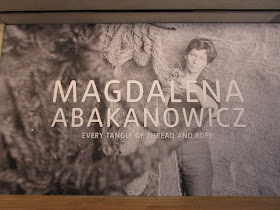"I am interested in constructing an environment from my forms.
I am interested in the scale of tensions that arises between the various shapes which I place in space.
I am interested in the feeling when confronted by the woven object.
I am interested in the motion and waving of the woven surfaces.
I am interested in every tangle of thread and rope and every possibility of transformation.
I am interested in the path of a single thread.
I am not interested in the practical usefulness of my work.
Magdalena Abakanowicz, 1971
I'd first encountered the large, sculptural textile works of Magdalena Abakanowicz in an exhibition devoted to art textiles back in 2015 (here). The sheer scale of that suspended piece had impressed me, dominating the central space of the main gallery at the Whitworth. Given my increasing interest in art textile practitioners then it was no surprise that I should find my way to this current exhibition at Tate Modern - Magdalena Abakanowicz: Every Tangle of Thread and Rope - celebrating an artist who deserves to be much better known. Such is the current interest in fibre art that last year alone I was able to enjoy significant exhibitions by other mainly female artists working in textiles. Artists such as Olga de Amaral (here), Lenore Tawney (here), Louise Bourgeois, (here) and Sue Fuller (here). All were very impressive enough, but the textiles here fall into a category of their own because their monumentality and the scale of Abakanowicz's vision and ambition. The exhibition begins chronologically documenting her first commercial pieces using printed textile techniques, and then the gradual incorporation of the loom as she moved into weaving, creating the most gorgeous textural tapestries. As a child Abakanowicz spent long periods wandering around the forests and fields of her aristocratic family's country estate absorbing the smells and textures of the trees. Also significant on her later work would be the animal skins and trophy heads collected by her father on hunting expeditions. As an art student during post-war Communist led Poland Abakanowicz had to follow the strict party line which didn't include any form of abstraction. She managed to negotiate her own aesthetic path through the Communist doctrine though, when censorship eased in the mid-1950s and she was freer to work the loom creating beautiful tapestries. To me these resemble large abstract expressionist paintings with the added richness and depth of textural fibres derived from fleece, cotton, horsehair and rope. This exhibition builds beautifully charting this development and then you walk into the third room where you encounter a forest of these works which were termed 'Abakans' by a bewildered critic. The vast tapestries of the late 1960s and early 1970s have now leapt off the gallery walls and hang suspended in time and space, clustered and arranged like a petrified forest or the forests explored in her youth. They are visceral, resembling flayed animal pelts or pieces of meat with fibrous tufts bristling along them like spines. they brought to mind the paintings of hanging meat by Bacon and Soutine. Abakanowicz at this stage had become fully engaged in what is known as 'loom-thinking' - improvised, instinctive, experimental weaving without preparatory design. In this she exploits and pushes the weaving process to bring new techniques and achievements to the discipline using different densities of materials and tensions on the loom but managing to blend them all seamlessly. Displaying her huge works in environments of "situations" as she liked to call them, but we now know as installations, was central to Abakanowicz's vision and such groupings only adds to the power of her work. As you emerge from the 'forest', the works hung and gathered in the next room are just as gargantuan but have had an injection of colour. There are rich burnt oranges, acid mustard yellows and vivid scarlets, very different to the earthy, muddy palette of the 'forest'. These circular-shaped pieces take their inspiration from bodily parts. There is a massive pair of blackened lungs, and other colourful pieces based around bodily orifices with fabric contorted into labial folds. This is a wonderful exhibition. As with the Sophie Tauber-Arp exhibition (here), Tate Modern are doing fantastic job of introducing the public to very talented but sadly overlooked female artists.
Magdalena Abakanowicz: Every Tangle of Thread and Rope
until 21st May
Tate Modern
Bankside
London
SE1




































































No comments:
Post a Comment